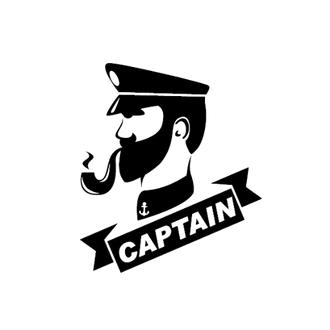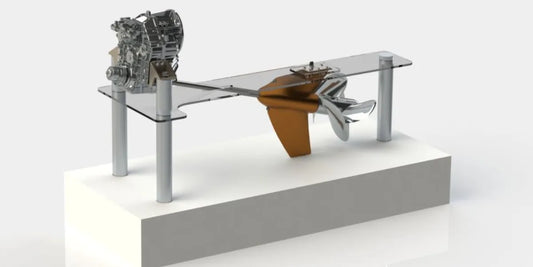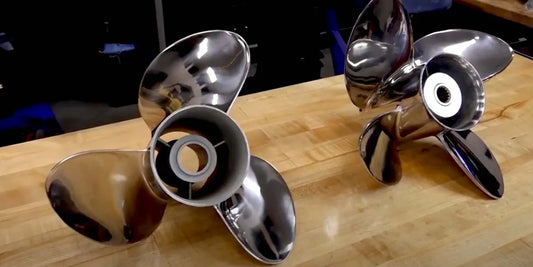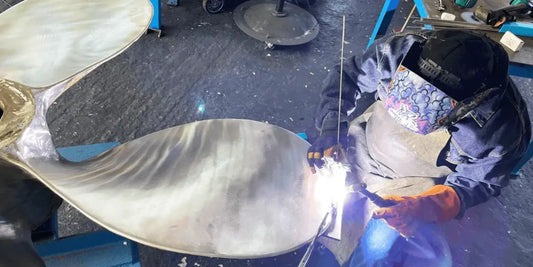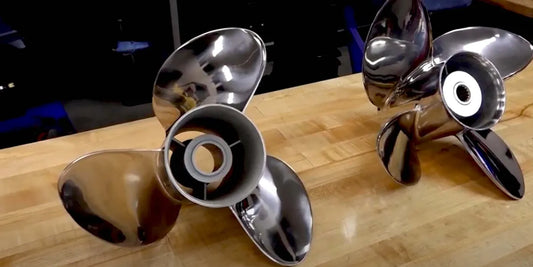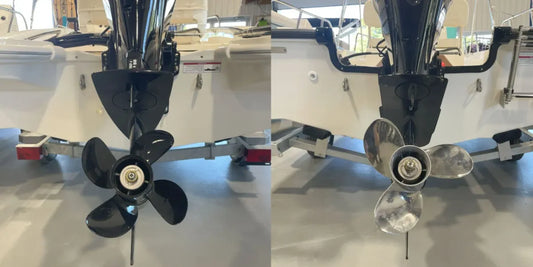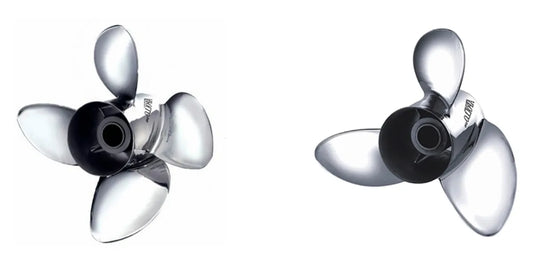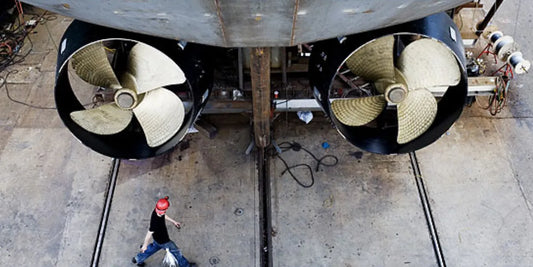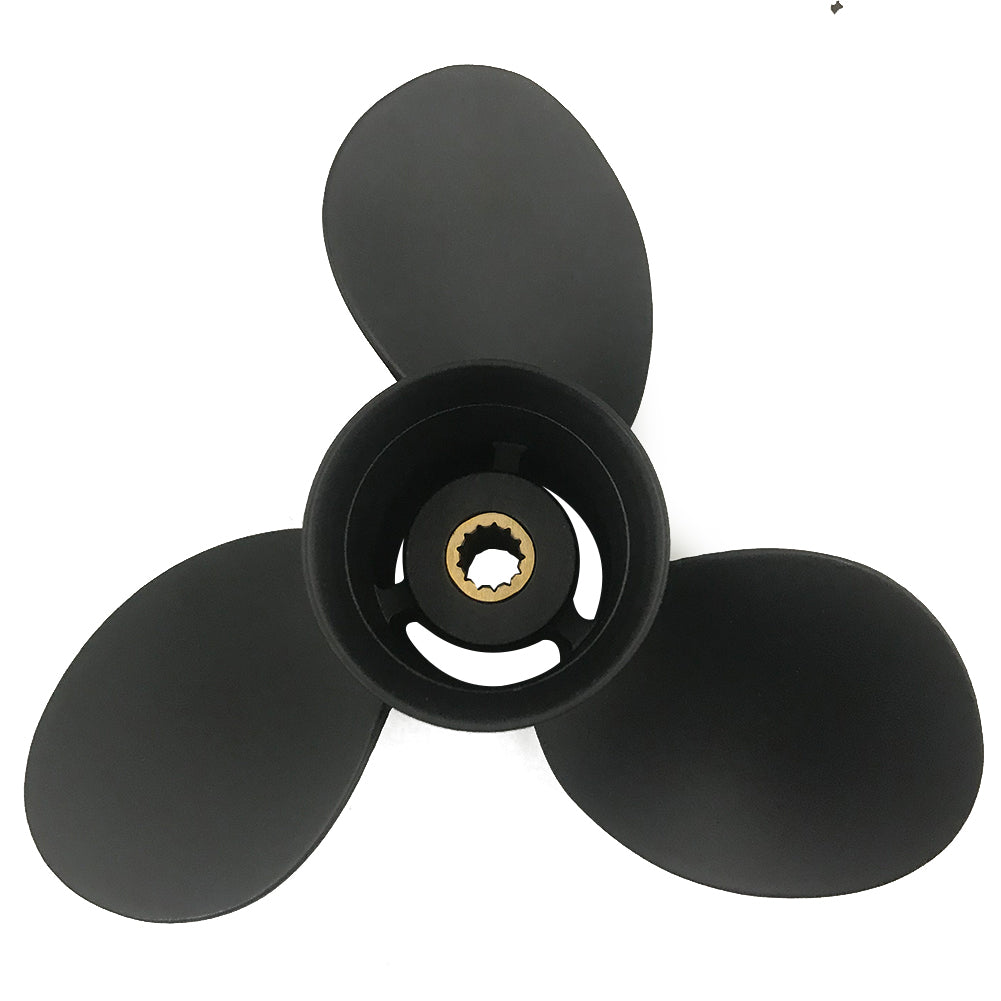The power machinery that motorizes the boat is a crucial choice in the design stage because it significantly influences the boating experience. Any professional sailor, as well as a new person gliding on the water, must distinguish among the main differences, benefits, and disadvantages of each motor type to make an informed decision. This guide will make that process easier by presenting important considerations concerning performance, maintenance, price, and intended purpose. By the end of this discussion, you will be well-informed about which motor will best suit your needs and lifestyle considerations for boating. So, let's first discuss the advantages and disadvantages of inboard vs. outboard motors, so that you can sail into the sunset prepared.
Understanding Inboard and Outboard Motors

What Is an Inboard Motor?
An inboard motor is an engine located amidships or, more commonly, near the center. This placement helps keep the center of gravity low, enhancing stability and balance, especially in the bigger types. This engine connects directly to a drive shaft that propels the propeller beneath the bottom. Inboard motors remain fully enclosed inside; thus, inboard motors seldom have to worry about corrosive water or debris, unlike outboard motors.
The inboard motors genuinely are known for their powerful performance and are recognized for activities such as water skiing, wakeboarding, and long-range cruising. They can be run on various types of fuel, with diesel engines being more fuel-efficient and having long durability. However, in general, it is often said that an inboard engine requires more complicated maintenance and servicing due to its positioning. They can, at times, restrict the interior space of the boat, something that is generally well thought of in boat design.
Inboard motors today are equipped with the latest fuel injection systems and emission controls, enabling them to perform at their best while being environmentally conscious and adhering to more stringent regulations. Placing power and smooth performance at the top of their priority list, most owners of purpose-built vessels, such as yachts or wake-sports boats, will opt for an inboard motor.
What is an Outboard Motor?
An outboard engine is a self-contained propulsion unit mounted on a boat's transom. It is an integrated package that combines the engine, transmission, and propeller to ease installation and enhance versatility. Suitable for smaller boats, fishing boats, and recreational activity boats, outboard motors can be easily removed.
The use of modern technology in contemporary outboard motors enables improved fuel economy, reduced emissions, and enhanced performance. Four-stroke engines are considered standard at the moment as they are quieter and more environmentally conscious than the older two-stroke types. Also, with the advancement of electronic fuel injection, variable valve timing, and digital controls, it ensures smoother rides and a more performance-optimized power delivery.
Such devices also offer practical advantages, including ease of maintenance and increased flexibility in shallow water, as they can be tilted to prevent damage to the propeller. High-performance models vary in size and power, ranging from those designed for small dinghies to those suitable for larger offshore fishing boats. Due to their ease of use and ever-improving technologies, outboard motors are popular among boating enthusiasts worldwide.
Key Differences Between Inboard and Outboard Motors
When comparing these two, it becomes easier to determine which one best suits a particular use by understanding the differences in the concepts that distinguish one from the other. One of the fundamental differences lies in the location and design. An outboard is externally mounted on the transom, making maintenance and repairs fairly easy. In contrast, an inboard motor is located within the hull of the boat, resulting in a streamlined design but also restricted access for servicing.
From a performance standpoint, asking an outboard motor to perform multiple functions and tilt made it ideal for shallow-water navigation. They are also lighter, which raises speed and saves fuel on smaller crafts. On the other hand, these may be considered as more powerful engines and work best for large craft that operate in deep water. The engine placement within the hull provides for better weight distribution, smooth handling, and stability, imparting some motion in the fury of higher waves.
Another aspect of differentiation revolves around noise. Whereas an outboard motor will be noisier due to its running technology, an inboard motor runs quieter because it is located inside the boat and partially insulated. Nonetheless, concerning maintenance, outboards hold the advantage as they can be easily removed for servicing, whereas inboard motors require specialized tools and expertise.
Cost considerations also greatly differentiate these motor types. Outboard motors can be more affordable for smaller boats, as their installation is easy and their upfront cost is usually low. Conversely, inboard motors typically require a substantial initial investment but can offer greater longevity and improved performance on larger vessels that are used frequently.
Ultimately, the decision between inboard and outboard will consider vessel size, usage, environmental factors, and budget. Both types continue to receive technological improvements, allowing for configurations to be fine-tuned to match a wide range of boating lifestyles.
Advantages of Inboard Motors

Performance and Handling Benefits
Classic inboard motor propulsion is well-suited for the highest performance needs of giant yachts, cruisers, and watersports boats. The motors are centrally installed within the hull, further improving the weight distribution and hence offering enhanced stability and better handling, especially at higher speeds or when making sharp turns in choppy waters. Additionally, inboards are essentially a direct-drive system, featuring low drag that enables efficient propulsion, resulting in very smooth rides and genuine fuel economy over longer distances.
Another significant advantage is precision and control, particularly in activities such as wakeboarding, water skiing, or extended offshore cruises. Multiple inboard systems can integrate with advanced technologies, such as joystick control, a dynamic positioning system, or settable trim parameters. All these features provide the operator with greater maneuverability, making docking, anchoring, and complex navigation easier. Finally, with quieter operation and reduced vibration, passengers can take comfort during longer trips.
Beyond performance and handling, another advantage of an inboard is its capability to withstand harsh environments. Their enclosed design severely restricts the ingress of corrosion-causing elements and debris-forming contaminants. So, they are mostly preferred where marine performance is paramount. If appropriately maintained, these motors can withstand harsh environments to provide stronger power for other aquatic activities. Altogether, the boaters who carry the highest expectations of power, control, and life expectancy for their boating require inboard motors.
Space and Weight Considerations
While evaluating the inboard motors, space and weight were of key consideration, as these two elements ultimately determine the motor's performance and usability. The very idea of an inboard motor would mean it is installed within the hull, thus preserving what little deck space is available while providing an uncluttered layout for passengers or gear. But inboard motors usually tend to be heavier than outboards, therefore altering the weight distribution on the boat and, consequently, its handling. To counterbalance this effect, however, many modern designs have followed a trend towards employing compact and light materials for construction, such as aluminum or composites, which reduce the motor's footprint yet do not underrate their power output. Then, even further ahead in engineering solutions, stands the even distribution of weight throughout the vessel, thus giving it greater stability and fuel efficiency. This way, the space-weight dynamic is optimized from the boater's perspective, and it is all about achieving maximum functionality for an elegant and efficient ride.
Durability and Maintenance Considerations
The present series of outboard motors is generally designed for durability and hence is manufactured with advanced materials and coatings to resist corrosion, especially in marine environments. In the case of saltwater exposure, for example, a saltwater-resistant alloy would be chosen for construction, while an anti-corrosion paint would be applied on parts subject to corrosion. Manufacturers also seal out water ingress through electrical systems and housing enclosures, thereby significantly minimizing moisture ingress into the components and increasing the engine's lifespan. All these enhancements mean that the outboard motor can withstand extended use with minimal wear, making it a trusted companion for both recreational and commercial boaters.
Concerning maintenance, newer outboard motors are now equipped with features that require less upkeep, thereby delivering the highest performance. Self-flushing systems are one such example: after every use, the user simply has to flush the system with fresh water, washing away salt and debris that would otherwise accumulate. These days, many models also come equipped with diagnostic systems that deliver real-time data on engine performance and provide very accurate alerts regarding maintenance needs. This, by itself, makes checking easier and eliminates the factor of unexpected breakdowns, thus saving a lot of time and money for boaters in the long run.
Conversely, there is an increasing emphasis on manufacturers to service their products by implementing modular designs for easy access to essential components. Such a design allows for a quicker service time by reducing disassembly and repair times. In conjunction with the increased availability of maintenance kits and easy-to-use manuals, owners of outboard engines have the means and resources necessary to maintain their engines properly. These developments enhance the overall user experience, allowing boaters to enjoy their reliable and long-lasting investment with the least amount of hassle and greatest peace of mind.
Advantages of Outboard Motors

Portability and Ease of Use
Outboard motors are highly appreciated for their portability, which suits the diverse range of boating situations. Unlike inboard motors, outboard engines are compact, lightweight, and easy to install or remove. This very design has afforded boat owners the ability to transfer the motor from one boat to another or place it in a well-protected studio indoors to avoid exposure to environmental factors that could cause wear and tear on the motor. Thus, it allows for easy detachment of the motors during transport, enabling users to have control over their equipment, regardless of the location or boating needs at hand.
Further, the intuitive design of a modern outboard engine makes it more attractive. Mechanically, one could have options such as an electric start, Hogan controls, or steering mechanisms that made the power input very fluid and easy, even for a beginner maintainer. Maintenance was made easy by allowing access to various parts and components, making inspections and repairs possible in just minutes. Some motor models may have self-diagnosis systems and digital displays that provide immediate alerts on potential problems, allowing for corrective action to be taken promptly. These cherished innovations, when combined, give the boat the highest level of convenience and compatibility necessary for waterborne adventures.
Fuel Efficiency and Cost-Effective
Making boats more fuel-efficient leads to lowering cost implications and environmental issues. Considering modern engine designs with the implementation of direct fuel injection and combustion system improvements, significant improvements in fuel economy can be achieved. With hull materials designed to minimize weight, the fuel consumption is excellent due to reduced drag. By cutting down fuel consumption, the boat owners manage to save a good amount in operational costs as their carbon footprint also becomes less. Thanks to the environmental consciousness of the new generation of boat enthusiasts and regulators who set standards on this concern.
Apart from that, the introduction of hybrid propulsion systems and energy recovery technologies marked new trends in the boat industry. A hybrid system enables the boat to utilize electric power during low-speed operations, such as docking or cruising at a calm pace, thereby minimizing its reliance on fossil fuels. Certain modern-day vessels are equipped with renewable power technologies, such as solar panels, that supply electricity for on-board systems. These methods assure that the boat can now be more sustainable and affordable, especially for owners who wish to strike a balance between performance and green conscience. Putting it all together, fuel efficiency has become a significant factor in affordability and sustainability for today's boaters.
Flexibility in Maintenance and Repair
Modern boating technologies have transformed the approach to vessel maintenance and repair, with a focus on enhancing flexibility and minimizing costs for boat owners. Most modern boats include modular systems whereby single components can be easily replaced without the necessity of extensive overhauls. The fine points of repair and troubleshooting can be adjusted to a targeted operation, saving a significant amount of time and money. Consequently, diagnostics have become more technologically advanced, alongside an onboard monitoring system that extracts and foresees potential problems for the user before they arise. This greatly enhanced technology places the boat owner in a position to maintain his vessel for long life with good performance.
For repairs, accessible resources and improved parts availability have streamlined the process for professional repairmen and do-it-yourselfers. Manufacturers now design components to be user-accessible, allowing for any form of maintenance, such as engine checks, system updates, or hull repairs, to be performed without the need for expert knowledge. Many of the same companies also offer online support, virtual assistance, or step-by-step guides to simplify their repair techniques further. More autonomy reduces the need to resort to marine service centers, making boating a lot more attractive for newcomers who might have otherwise found maintenance requirements intimidating. All of these advancements are actually in favor of enhancing the overall user experience for boats.
Disadvantages of Inboard Motors

Initial Cost and Installation Challenges
One of the greatest challenges for prospective boat owners may be the initial cost of inboard-type motors. Normally, these systems are more costly than their outboard counterparts, which means the prospective buyer has to consider a higher upfront investment that might be prohibitive due to their tight budget. Then again, this may not be all, as additional expenses such as customizations, controls, and other equipment may be required for the setup and operation of the system. For new boat buyers, the presence of an inboard motor can raise the base price of a boat, thereby keeping it out of reach for first-time boat enthusiasts. Then come the further expenses wherein servicing and repairing inboard motors likely require specialized attention, and thus, may warrant costlier bills than outboard motors, which can be serviced and repaired anywhere with ease.
Installation challenges should also be taken seriously, as they impact the choice of an inboard motor. They are usually fixed to the hull of the boat, requiring a considerable amount of labor and precision engineering. In contrast, outboard engines are simple to install and replace. Inboard motors involve a more time-consuming and complex process. For anyone retrofitting older vessels with an inboard motor, that means potential alterations to the boat structure. These hurdles, along with the costs involved, can overshadow the benefits that inboards provide to some users: namely, people seeking a pleasure vessel that is inexpensive and straightforward to maintain.
The price and complexity of inbiotic motors are the paramount deciding factors considered by consumers. Awareness of these factors would help boat owners make informed decisions, taking into account budgetary constraints versus expectations regarding performance and maintenance.
Maintenance Complexity
Maintenance of an inboard motor is comparatively complex compared to outboard motors; this higher complexity is primarily due to the fact that it is not as easy to access inside a boat. These systems are inside the hull, which requires time and expertise for routine inspection or repairs. Cooling systems, exhaust paths, and similar components typically require attention to mitigate operational conditions, environmental hazards, and wear and tear. Hence, integration with the inboard motors of other systems may require more troubleshooting and higher repair costs should actual problems arise.
On the other hand, technological advancements and improved system designs are slowly addressing some of these issues. Modern outboards often feature more diagnostic tools and fewer bulky components, reducing the time and skill levels required for servicing. Completely aware of these maintenance considerations and the most common repair requirements, a boat owner will be well-positioned to devise an all-encompassing scheme for upkeep that ensures excellent performance and reliability in the long run.
Limited Space in Smaller Boats
The limited space in smaller boats presents a unique set of challenges for owners, particularly when attempting to make the vessels both functional and comfortable. Creative storage and layout solutions are often necessary for these smaller versions. Some features and furniture are designed to be modular and adaptable to their purpose, such as foldaway tables or secret compartments, to name just a couple of ideas that manufacturers are using to tackle this issue.
In vessels smaller than boats, mechanical considerations can make it difficult to install a larger or more advanced system, such as an inboard motor, for instance, or advanced navigation equipment. Hence, something smaller and more efficient must be installed, which often features space-saving configurations. The paradox of the engine with a small footprint is itself the aberration that paves the way for better performance in tight places. With less than 100 feet of marine hardware, organized modular systems allow smaller boats to have fun and be practical on the water without compromising the functionality necessary for any task at hand.
Disadvantages of Outboard Motors

Vulnerability to Damage and Theft
Outboard motors offer certain flexibility and convenience; unfortunately, they also carry a higher risk of exposure to environmental elements and external impacts compared to inboard engines. They lie outside the hull and are hence more vulnerable to physical damage from underwater debris, collision, and harsh weather conditions. For example, submerged rocks, driftwood, or other obstructions can easily scrape the propeller or lower unit of the outboard motor, resulting in expensive repairs. Moreover, damage can set in if good maintenance is not carried out in time to prevent saltwater corrosion, thus further impairing the engine workings and lifespan. Regular cleaning, anti-corrosion treatment, and thorough inspections are essential in preventing such eventualities and prolonging the motor's life.
Other than physical destruction, theft is particularly worrisome for outboard motor owners. Being compact and externally mounted, they appeal to thieves, especially in unattended secure areas such as public docks and marinas. According to boating safety organizations, outboard theft has become so rampant that it has prompted owners to invest in additional security measures, such as engine locks and GPS trackers, to deter potential thieves. Keeping one's vessel tucked away in a secure place and periodically marking or engraving identifiable components of the motor with a unique code can also help prevent theft and facilitate recovery of the motor should the worst happen. By doing so, the boat owner reduces the vulnerable gaps, thus bringing some level of peace of mind when it comes to outboard motor security.
Noise and Vibration-Related Issues
Sometimes, outboard motors can be a nuisance with noise and vibration, which significantly impact the overall water experience. Noise can spoil conversations, scare off wildlife, or distract from one's enjoyment, while the vibrations induce discomfort in people and might gradually wear out the components of the craft. Hence, the modern technology behind outboard motors attempts to counteract noise and vibration using manufacturers designing quieter engines and applying the latest damping technologies.
For instance, newer four-stroke motors are designed to produce significantly less noise than the older two-stroke variety, thanks to improved muffler designs and precision manufacturing. Vibration reduction systems, advanced mounts, and counterbalancing techniques are employed to ensure smooth and steady operation. Maintenance, including the replacement of worn parts and motor alignment, is key to controlling noise and vibration while ensuring quiet and smooth operation. Silent and smooth operations enhance the products' usability, lifespan, and hence overall consumer satisfaction if both manufacturers and buyers value them.
Potential for Reduced Stability
There are several reasons why outboard stability could be compromised, including uneven weight distribution, improper maintenance, and other factors that I may not have mentioned. With the outboard not being properly balanced or set at the correct height, the boat would perform slightly worse, exhibiting more rocking in the wake, and would be difficult to steer in choppy waters in the desired direction. These only add to the layers of age deterioration that threaten bushings and mounts, intensifying vibrations and obstructing safety. Industry reports emphasize that the hull design, secure placement of motors, and efficient performance of propellers must be thoroughly inspected to ensure smooth maneuvering and stability. Manufacturers own boats; design engineers are incorporating new features, such as self-leveling devices and trim controls, that can be finely adjusted by end users for improved balance. Concentrate on these developments and a regular maintenance plan, and make the whole stability issue a thing of the past.
Making the Right Choice: Inboard vs Outboard

Assessing Your Needs and Preferences
With the inboard/outboard decision, I focus on my specific boat needs and preferences. For me, it stems from the activities I enjoy most on the water. When I participate in water sports like wakeboarding or skiing, I opt for inboards because the wake pattern is smoother, and they produce more mid-range torque to tow. If fishing and general versatility are my preferences, outboard engines come to mind due to their compact design, ease of maintenance, and quiet operation at low speeds.
Another thing I consider is maintenance, and how comfortable I feel with this aspect. Outboard motors are generally considered easier to service, as they sit on the outside of the boat, allowing for relatively quick access for repairs or upgrades. In contrast, inboard motors, due to their placement within the hull, often require specialized maintenance but usually maintain a clean transom and subject crucial components to less exposure to the elements. The budget is also a deciding factor, as outboards come in a wider range of prices, making them a more attractive option for budget-conscious buyers.
Finally, I weigh the overall performance and long-term investment. If I’m looking for a powerful, streamlined experience and plan to use my boat for extended outings, an inboard engine offers reliability and a quieter cabin experience. However, for flexibility, quicker acceleration, and better maneuverability in shallow waters, the outboard engine consistently proves its value. Considering these aspects helps me align my preferences with the best engine type for my boating lifestyle.
Considering Boat Type and Usage
Boats certainly figure into my choice of engine type, so does the type of activity I plan to engage in while on the water. For a bigger boat or a vessel that really wants the least space possible for engine installation, an inboard engine is preferable, which will also go for so that it provides for a smooth and quiet ride, giving more room for the guests on deck or at the cabin for amusement or for taking proper away cruises. In case I am cruising or fishing offshore and farther away, I would go for an inboard for its power, efficiency, and long-term reliability.
Nevertheless, if my boating activities are frequent dredges in shallow waters for watersports or requiring maintenance as little as possible, an outboard engine is the most practical choice. Acceleration is impressive with an outboard, making it great for quick maneuvers on smaller, agile boats. Additionally, the ability to raise the engine out of the water prevents corrosion from setting in, which is a significant advantage for someone like me, who might consider docking or trailering their boat frequently. Balancing boat design with my favorite activities would be a wise decision, allowing my selection to be tailored to my needs and lifestyle.
Cost Analysis and Long-term Considerations
When considering the cost, as I see it, there can be an initial appeal to an outboard, given that it can sometimes be priced a little less than an inboard on the open market. Not only is spending less an initial benefit, but maintenance costs are also lower. Being more accessible for fixing and routine maintenance, there are fewer costs associated with labor and servicing time. For those who consider time and money both precious, these factors greatly support an outboard setup.
Fuel economy is another important consideration. Outboards tend to be more fuel-efficient, given that the majority of speeds used by their owners are pretty low, or the distance covered by their frequent trips is very short. This suits me well, as my outings are typically short and restful, often involving cruises or fishing. With such tiny fuel savings accumulated over time, the outboard is almost more economical in the long run.
<Durability and resale value>. Well, it is indeed said that being more robustly built, inboard engines may last longer; yet, technology has saved us great breath as far as outboards are concerned. Outboard boats also resell well and are therefore easy to make upgrades to soon. So, both from the money-making point of view and the practical one, outboards fit very well my criteria for an economic option, having the practical attribute and yet being variously usable.
Reference Sources
-
Outboard vs. Inboard: Which Motor is Right for You? - Discover Boating
Explains the differences in servicing, maintenance, and overall usability of inboard and outboard motors. -
Inboard vs. Outboard Motors: Which is Best for Your Boat? - Sportsman Boats
Highlights key differences in performance, speed, space, layout, and maintenance. -
Outboards vs. Inboard/Outboards: There's a Clear Winner - Foothills Marine
Discusses the advantages, disadvantages, and use cases of each motor type, along with recommendations.
Frequently Asked Questions (FAQs)
Wherein do the differences between inboard and outboard motors lie?
There are several key differences between inboard and outboard air, based on their location and performance. Traditionally, an inboard engine is located inside the boat, usually near the center of the boat, while an outboard motor is attached to the transom of the boat. Positioning of the engine thereby affects how the boat handles, with inboards usually striking a better balance and achieving better stability. Moreover, inboard engines can supply much more horsepower for larger boats and, hence, are suitably placed for heavy-duty applications in the marine field. Outboards, on the other hand, are easiest to repair and replace, thus cementing their preference among owners of small boats. Understanding these differences will help you select the best type of engine for your boating needs.
What are their pros and cons, one for inboard and the other for outboard?
When considering inboard versus outboard motors, several advantages and disadvantages must be weighed. Inboards tend to offer better performance and fuel economy for bigger boats, whereas outboards are lighter and easier to repair. One major drawback of the inboard engine is that it has restricted accessibility for maintenance due to being built within the boat's engine compartment. Conversely, outboards are fitted on top of the transom of the boat and are hence easy to maintain. Corrosion is a problem outboards have, especially with saltwater, resulting in more frequent maintenance. It comes down to your own needs and the type of boat you have.
How does the choice of an inboard or outboard motor affect the performance of a boat?
Inboard and outboard motors considerably influence a boat's performance. Inboard motors generally offer power and torque; hence, they are well-suited for larger craft and ski boats that require high horsepower. Usually, they are quieter during operation, too, which can enhance the overall boating experience. Outboards, conversely, are typically lighter, which allows for fast acceleration and makes them highly maneuverable. The very placement of the engine will determine how the boat sits in the water, with inboards having a lower center of gravity, thus enabling improved stability. Knowing how each motor type ultimately impacts performance could improve your choice of the motor most suitable for your boating activity.
What type of boat is better suited for inboard vs outboard motors?
The boat type offers a moderate selection between inboard and outboard motors. Bigger boats, such as cruisers and powerboats, often favor inboard engines, which are primarily designed for power and improved fuel economy. Conversely, smaller boats, such as deck boats and fishing boats, find it easier to have outboard motors mounted for simplicity and easy maintenance. There are also boats for shallow water that should have outboard motors, allowing them to be tilted up to avoid obstacles. Ultimately, it comes down to how you plan to use the boat and what you prefer.
What are the maintenance differences between inboard and outboard engines?
Maintenance requirements differ significantly between inboard and outboard engines. Inboard motors, often resembling automotive engines, require more complex maintenance due to their installation inside the boat. Accessing the engine compartment can sometimes be a challenging task, not to mention the complexity of performing regular checks and repairs there. In contrast, outboard motors are outside the boat, allowing for easy servicing and repair. Outboard engines, therefore, might face less maintenance costs. Still, being outside exposes them to problems such as saltwater corrosion, which necessitates regular servicing. Understanding these differences can guide you into planning your boat's long-term maintenance.
Which motor do you need then: inboard or outboard?
Choosing whether an inboard or outboard motor would suit you depends on numerous factors, including your boating style, the type of boat you own, and maintenance preferences. If you are into high outside activities, such as watersports or saltwater fishing, outboard motors could be the best choice for their agility and ease of maintenance. On the other hand, if more emphasis is put on stability and power for cruising or long trips, then inboard motors will be preferred. Also, ponder over other advantages and disadvantages of each type of engine, such as operating costs, availability, and accessibility of repairs. In short, weighing your notion of boating will have the final say on the issue.
